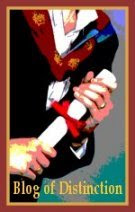
The nights are getting much cooler now, and we have awakened to a chilling blanket of fog each of the last several days. By the second week in September, towns 100 miles to our north are reporting their first frosts. At our house, nighttime temperatures still cling to the lower 40s—not cold enough for our first crystalline morning, but chilly enough to push back Ari’s routine several hours.
Each morning, she gently wakes me around 6:00, and the two of us stumble downstairs. As I wait in the warmth of the foyer, she hurries down the steps of the front porch, into the pine grove, and then back inside. The whole process takes no more than five minutes, but her coat still absorbs the chill of the air—and some of its moisture, too. Without even asking for breakfast, she then alights up the stairs and jumps into bed—a new resurgence of her puppy behavior. But on these mornings, she’s not interested in ensuring that we are stirring, or even playing. Instead, it’s our quiet warmth she seems to value most of all, and she works hard to insinuate herself in one of the pockets created by two drowsy bodies. The absence of Cam means she no longer has to vie for space, and we no longer have a reason to eject the pup. To the contrary, I find a kind of bittersweet solace in another furry mammal curled up in the crook of my knees.
Our walking schedule has changed as well. No longer avoiding the heat of high noon or the bugs that arrive a few hours earlier, we linger in the house another few hours: Ari curls up nose to tail in her dog nest; Greg dons a sweatshirt before retreating to his loft office; I settle on the couch to write with a cup of tea and thick wool socks. We all agree: we’ll wait out the cool dampness before traipsing down the dirt road. Outside, a million different organisms seem to be making the same decision. The morning is quiet, save for the tempered shriek of a bluejay. No squirrel chases; no crickets, crows, or barking neighborhood dogs to stir activity in our cozy mammal den.
By 10:00 a.m., the temperature differential shifts, and it is warmer outside than in. Greg and I open a few windows to let in the newly-heated air. With it also come the tunes of an environment stirring: the rising pulse of locust, the dusty sweetness of one last haying. The pup catches both the scent and sound. She raises her head, then cocks one ear and half her nose in the direction of the window. Interesting, she seems to say. She rises with a long, streching bow and shakes off the cool air. Time for a walk.
These days, we opt for the familiar—down the drive and over towards Stagecoach Road. But as we have already learned with the start of spring and then summer, this route is familiar in name only. The sun has moved perceptible degrees to the south, casting new shadows on the drive and illuminating patches of ground and brush we previously ignored. Working in concert with all of that nighttime moisture, it has also created a dizzying display of illuminated spiders’ webs and browning weeds. Ari seems impressed. I tell her it will only get more amazing as we complete the arc towards a frosty winter, but she gives me a look that suggests I might be once again showing off. I recant and return to the silence of our midmorning walk.
We make our way to our usual terminus: Martin Stream. Its pools are quiet and cool in the morning shade. But unlike most days, the pool is inhabited this morning—its uniformity broken by a single object floating on the surface. For a moment, I worry it is another carcass Ari will want to embed in her coat. I wind her leash tight around my hand since neither one of us wants to endure a bath today. But as we get closer, I see that the object is very much alive. And very much an enormous beaver (Castor canadensis).
Our field guide describes beavers as hefty rodents with disproportionately large skulls. Whoever wrote that hasn’t met this particular beaver, whose immense body positively dwarfs his skull. Then again, the guide also insists that beavers are both nocturnal and group-oriented. Either I need a new guide or this lone paddler hasn’t read up on his rodent natural history.
Beavers are impossibly improbable animals. Observed head-on, they seem like over-inflated balloons with whiskers. Their flat, narrow faces are identifiable only because of the whorl of two nostrils and their enormous ochre teeth. I don’t if that’s mythic or comic. Maybe both. Robin Williams once joked that platypuses are proof that God likes to get stoned. If not further proof of this irreverent idea, beavers at least suggest that metaphysics has a sense of humor.
In spite of their strange appearance (or perhaps because of it), beavers exert an almost inconceivable effect on the natural world. In the northeast, their dam building has had more effect on topography than any other naturally-occurring force. Beavers create their own habitat, impounding water and creating marsh or entire ponds where there was once just the trickle of a stream. This process has a radical effect on an ecosystem, altering entire flora systems and, in turn, modifying what scientists call the “biogeochemistry” of a region. This is turn creates a new cycle of chemical compounds that dictate who and what can live within a particular biome.
Ari also seems to appreciate the cosmic sway of the beaver, albeit for very different reasons. Although the one paddling before her has impossibly tiny eyes and ears, both are clearly big enough to hone in on my curious dog. Theirs is clearly a mutual attraction. I give Ari the full length of her leash and try to make myself invisible behind the lip of dirt separating trail from stream. I want to see how the two of them will interact with limited human intervention.
The beaver doesn’t seem to care one way or another about my presence; instead, it is captivated by the pup. They watch one another for a few seconds. Then, after deciding Ari is not enough of a threat to warrant a hasty retreat, the beaver paddles over to the edge of the pool and pulls itself heavily to land. Even with his long bat-winged feet and thick frame, this beaver is remarkably nimble on land and makes his way to Ari in a single heartbeat. They are now just inches from one another, standing nose to nose.
I freeze. Never in our entire project has a wild animal approached Ari like this one is. I watch them closely, ready to yank Ari well away if the beaver shows any signs of aggression or diseased behavior. It doesn’t, and so I hold my breath as the pup studies this new creature. She is pure electricity as she does—dancing from foot to foot and reaching out with her nose, only to quickly reel it back in. Intrigue and uncertainty battle in the mind of this dog. Or perhaps she is merely trying to make sense of this creature by way of comparison: Hmmm, round like the neighborhood pigs, but much smaller. Compact like Cam, but not trying to claw out my eyes. Another red squirrel? Definitely not. And then there is that exotic, musky smell. Pretty darn alluring, if I may say so.
The beaver inches closer. The two animals are now an inch apart from one another. They are entranced, and the rest of the world, including me, has melted away. What they are experiencing is intimacy in its purest form. They are, cognitively speaking, completely within one another.
This interaction—what Annie Dillard calls “mindlessness” and “purity of living.” Both are states dogs and beavers clearly understand. Ari has no qualms about giving herself over to mindlessness. Or perhaps more exactly, she surrenders to a special kind of mindfulness: one that surpasses mere recognition of the moment and enters a more immediate kind of awareness not interrupted by concentration on the self. A kind of rapture.
Almost every Eastern culture has an account of this state. In Sanskrit, it is called Dhyāna; in Japanese, it is Zen. In Ari’s homeland of Korea, Buddhists refer to this state of meditation as Seon. All agree that this is a high level state of existence and communion.
Ari doesn’t care about whether this is elevated consciousness or not. And that’s the brilliance of her state of mind at a time like this. There is no metacognition or thinking about thinking; there is just experience itself. I have no idea what this feels like. I want to, though. And that’s the paradox: as soon as I consciously want this state, I have interrupted it. In the case of Ari and the beaver, my stirring—my elation and surprise over their encounter—breaks the spell between these two animals, sending the beaver on its way and leaving a stunned pup to slowly regain her sense of the surrounding world.



















